-
Countries
-
Data and Analysis
-
Special Focus
-
Crisis Responses
Site Assessment

Contact
DTM South Sudan, SouthSudanDTM@iom.int
Language
English
Location
South Sudan
Period Covered
May 01 2024
May 31 2024
Activity
- Registration
- Flow Monitoring
- Mobility Tracking
- Site Assessment
At the end of May 2024, 137,536 individuals (31,033 households) are biometrically registered as active beneficiaries in the site, representing an increase of two per cent of individuals since January following the latest biometric registration maintenance in Bentiu IDP Camp.

Contact
DTM Chad, dtmtchad@iom.int
Language
English
Location
Chad
Period Covered
Jan 03 2024
Feb 08 2024
Activity
- Mobility Tracking
- Baseline Assessment
- Site Assessment
Following the armed conflict in Sudan in April 2023, thousands of people were forced to leave the country and take refuge in Chad, mainly in the east. These Chadian nationals, who ahd been living in SUdan for many years, were registered by IOM in 41 displacement sites in the Sila and Ouaddaï provinces. The majority (61%) of the displacement sites are in the Adré sub-prefecture, and make up 55 per cent of the total returnee population in the two provinces.
The aim of the assessment is to measure the profiles, vulnerabilities and needs of the populatiosn displaced by this crisis, in order to better orient pprogramming of durable solutions for the displaced population.
Data was collected through itnerviews with key informants (local authorities, village chiefs, IDP representatives and site managers) in villages and IDP reception sites, as well as through direct observations in these localities.
This dashboard preents the results of assessments carried out from 03 Janaury to 08 February 2024, in 41 locations acorss the Ouaddaï and Sila proinces.

Contact
DTM Ethiopia, DTMEthiopia@iom.int
Language
English
Location
Ethiopia
Period Covered
Jul 01 2019
Jan 08 2023
Activity
- Mobility Tracking
- Site Assessment
- Village Assessment
The objective of this thematic report is to provide an overview of the International Organization for Migration (IOM)'s Data and Research Unit (DRU) data collected through its Displacement Tracking Matrix (DTM) methodology and Site Assessment (SA) and Village Assessment Survey (VAS) tools deployed at the location level in Ethiopia between July 2019 and January 2023. Through the SA, sites hosting at least 20 IDP households are assessed and, through the VAS, villages hosting at least 20 returning IDP households are assessed.
This overview gathers and analyzes specific data records on displacement and returns related to drought and other climate-induced factors such as floods, landslides and fires.
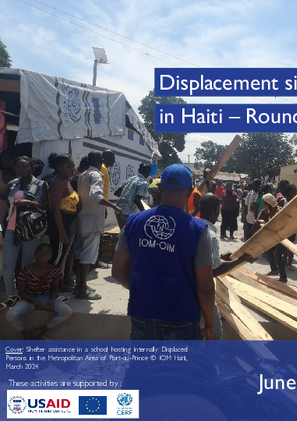
Contact
DTM Haiti, dtmhaiti@iom.int
Language
English
Location
Haiti
Period Covered
Apr 24 2024
May 31 2024
Activity
- Mobility Tracking
- Baseline Assessment
- Site Assessment
- Village Assessment
The Round 6, published in early March 2024, indicated that 362,551 people were
internally displaced in Haiti. This new Round indicates the presence of 578,074 internally displaced people, almost 60%
more than in Round 6. This increase is due to the deterioration of the security situation observed in the MAPAP, Haiti’s
capital, between the end of February and April 2024 in particular. The increase in the number of IDPs was more
identified in provinces where it increased by 95% (compared to 15% in the MAPAP). Indeed, following the increase in
violence in the MAPAP, many people fled the capital to seek refuge in provinces.
The Great South was the region that saw the largest increase in the number of IDPs hosted there (130% more
compared to Round 6). Nearly half (47%) of IDPs in the country are located in the Great South.
The majority of IDPs in the country are hosted in provinces: 68% in provinces vs. 32% in the MAPAP
The IDPs in provinces are mainly people who fled the MAPAP: 78% of IDPs in provinces came from the MAPAP.
Artibonite, where half of the IDPs fled areas located in this department, is an exception. In all other departments of the
country, IDPs mainly came from the MAPAP.
At the national level, the majority of IDPs are hosted by host families: 80% vs 20% in sites. However, in the MAPAP,
the majority of IDPs reside in sites (61% in sites vs 39% in host families), while in provinces the opposite is true (97% in
host families vs 3% in sites). It is crucial to support host communities in provinces, particularly in the Great South, to
enable them to continue hosting IDPs; and it is important to promote social cohesion between these two population
groups. Without the resilience of host communities, the number of sites in provinces is likely to increase as has been the
case in the MAPAP. Indeed, at the beginning of the crisis, the majority of IDPs in the MAPAP were hosted by host
families: only about 2 out of 10 IDPs were in sites in 2022; this figure increased to 6 out of 10 IDPs in 2023. One of the
main reasons for this increase was the lack of resources of host communities to continue hosting IDPs and the
deterioration of social cohesion in this context.
In addition, 50,000 returnees formerly IDPs were identified, particularly in the MAPAP, in Croix-des-Bouquets (21%),
Cité Soleil (14%), Port-au-Prince (12%); in the South in Tiburon (19%); and in the Center in Sauts d’Eau (10%). It should
be noted that for the moment these returns remain very fragile and are not sustainable, particularly in the MAPAP.
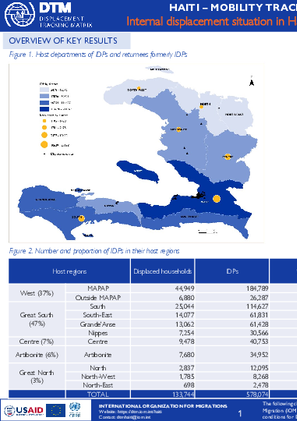
Contact
DTM Haiti, dtmhaiti@iom.int
Language
English
Location
Haiti
Period Covered
Feb 24 2024
May 31 2024
Activity
- Mobility Tracking
- Baseline Assessment
- Site Assessment
- Village Assessment
The Round 6, published in early March 2024, indicated that 362,551 people were
internally displaced in Haiti. This new Round indicates the presence of 578,074 internally displaced people, almost 60%
more than in Round 6. This increase is due to the deterioration of the security situation observed in the MAPAP, Haiti’s
capital, between the end of February and April 2024 in particular. The increase in the number of IDPs was more
identified in provinces where it increased by 95% (compared to 15% in the MAPAP). Indeed, following the increase in
violence in the MAPAP, many people fled the capital to seek refuge in provinces.
The Great South was the region that saw the largest increase in the number of IDPs hosted there (130% more
compared to Round 6). Nearly half (47%) of IDPs in the country are located in the Great South.
The majority of IDPs in the country are hosted in provinces: 68% in provinces vs. 32% in the MAPAP
The IDPs in provinces are mainly people who fled the MAPAP: 78% of IDPs in provinces came from the MAPAP.
Artibonite, where half of the IDPs fled areas located in this department, is an exception. In all other departments of the
country, IDPs mainly came from the MAPAP.
At the national level, the majority of IDPs are hosted by host families: 80% vs 20% in sites. However, in the MAPAP,
the majority of IDPs reside in sites (61% in sites vs 39% in host families), while in provinces the opposite is true (97% in
host families vs 3% in sites). It is crucial to support host communities in provinces, particularly in the Great South, to
enable them to continue hosting IDPs; and it is important to promote social cohesion between these two population
groups. Without the resilience of host communities, the number of sites in provinces is likely to increase as has been the
case in the MAPAP. Indeed, at the beginning of the crisis, the majority of IDPs in the MAPAP were hosted by host
families: only about 2 out of 10 IDPs were in sites in 2022; this figure increased to 6 out of 10 IDPs in 2023. One of the
main reasons for this increase was the lack of resources of host communities to continue hosting IDPs and the
deterioration of social cohesion in this context.
In addition, 50,000 returnees formerly IDPs were identified, particularly in the MAPAP, in Croix-des-Bouquets (21%),
Cité Soleil (14%), Port-au-Prince (12%); in the South in Tiburon (19%); and in the Center in Sauts d’Eau (10%). It should
be noted that for the moment these returns remain very fragile and are not sustainable, particularly in the MAPAP.

Contact
DTM Mozambique, DTMMozambique@iom.int
Language
English
Location
Mozambique
Period Covered
Dec 05 2023
May 29 2024
Activity
- Mobility Tracking
- Site Assessment
This Multi-Sectorial Location Assessment (MSLA) report, which presents findings from the International Organization for Migration’s (IOM) Displacement Tracking Matrix (DTM) Round 13 assessments, aims to enhance understanding of the extent of internal displacements and the needs of affected populations in conflict-affected and disaster-affected districts of Mozambique. Data was collected between 5 - 29 December 2023 in close coordination with provincial government and Instituto Nacional de Gestão e Redução do Risco de Desastres (INGD) partners, and presents trends from 190 assessed sites hosting internally displaced persons (IDPs) across Northern (Cabo Delgado 95 sites, Nampula 2 sites, Niassa 7 sites), Central Mozambique (Sofala 36 sites, Manica 35 sites, Zambezia 10 sites, Tete 3 sites) and Southern (Inhambane 2 sites).
A total of 317,224 (IDPs were reported present in all 190 sites assessed. This represents a reduction of 19 per cent from MSLA Round 12. Reported figures, however, exclude displaced individuals living in host community settings. According to DTM Round 20 Mobility Tracking Report, as of August, an estimated 709,529 were identified living in both host communities and sites (582,764 IDPs in Northern Mozambique, and 126,765 IDPs in Central Mozambique).
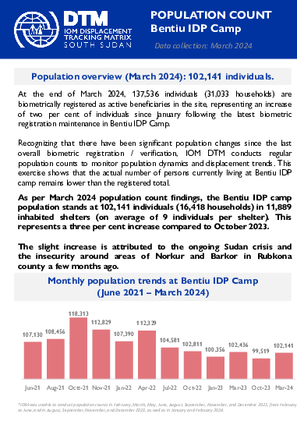
Contact
DTM South Sudan, SouthSudanDTM@iom.int
Language
English
Location
South Sudan
Period Covered
Mar 01 2024
Mar 31 2024
Activity
- Registration
- Flow Monitoring
- Mobility Tracking
- Site Assessment
As per March 2024 population count findings, the Bentiu IDP camp population stands at 102,141 individuals (16,418 households) in 11,889 inhabited shelters (on average of 9 individuals per shelter). This represents a three per cent increase compared to October 2023.
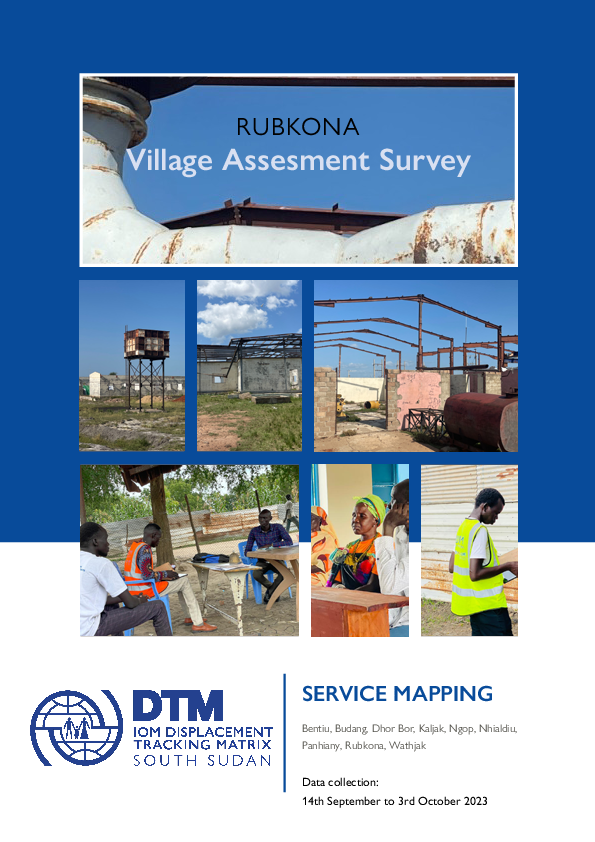
Contact
DTM South Sudan, SouthSudanDTM@iom.int
Language
English
Location
South Sudan
Period Covered
Sep 14 2023
Oct 03 2023
Activity
- Mobility Tracking
- Site Assessment
The data collection took place from September 14th, 2023, to October 3rd, 2023, covering a period of twenty days. The Displacement Tracking Matrix (DTM), a unit of the International Organization for Migration (IOM), conducted a 20-day Village Assessment Survey (VAS) in Rubkona County to assess transition and recovery needs. The survey focused on 09 Payam and 27 bomas accessible, as rainy season and flood limited access to some of the areas.
Of the 76 settlements assessed, 12 were found deserted while 64 remained populated. The survey meticulously mapped 240 facilities, 76 settlements, and 2 livelihood areas across the surveyed bomas. This includes 6 settlements in 6 bomas not assessed due to flooding. Among the 76-settlement identified, there are 37 neighborhoods, 30 permanent villages, 7 IDP sites and 2 temporary sites. The team managed to map 2 livelihood areas categorized into fishery grounds.
KEY FINDINGS
The assessment reveals a substantial number of destroyed or abandoned buildings, emphasizing the pressing need for housing reconstruction initiatives to address the housing crisis in the county.
Many areas within Rubkona County lack access to essential services such as education, healthcare, and markets, indicating a need for targeted interventions to improve service provision and overall community well-being.
In 67% of bomas, the fear of disasters, such as flooding, poses a substantial challenge for peaceful return, emphasizing the impact of environmental factors on human settlements.
A prevalent issue in multiple bomas across Rubkona County is the presence of individuals living on land/property without paying rent or obtaining permission from the owners, with 57% of bomas reporting such instances.
Most residential structures in Rubkona County lack permanency, characterized by the prevalence of temporary shelters such as tents and tukuls. These constructions are primarily composed of mud walls and thatched roofing, indicating a deficiency in durable and lasting housing infrastructure.
Critical need for improvements in school infrastructure, including insecure buildings, classroom shortages, insufficient furniture, and inadequate water and sanitation facilities, to create a conducive learning environment.
Urgent need for renovations, upgrades, and construction of permanent structures in healthcare facilities to ensure a safe environment for patients and healthcare workers.
The pressing need to rehabilitate non-operational boreholes to ensure a reliable water supply. the lack of water user committees in certain bomas inhibits local management of water resources.
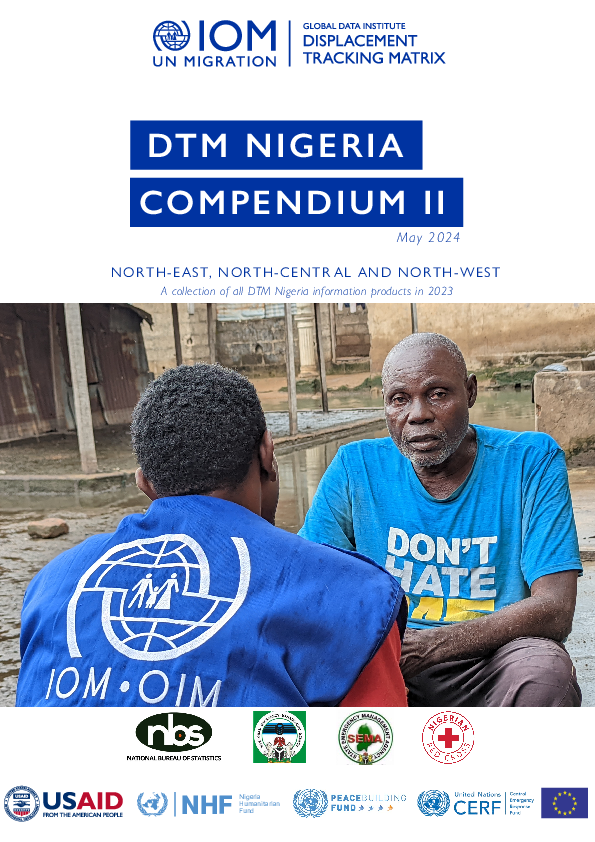
Contact
DTM Nigeria, iomnigeriadtm@iom.int
Language
English
Location
Nigeria
Period Covered
Jan 01 2023
Dec 31 2023
Activity
- Other
- Survey
- Flow Monitoring Survey
- Return Intention
- Registration
- Biometric Registration
- Flow Monitoring
- Mobility Tracking
- Site Assessment
- Event Tracking
A collection of all DTM Nigeria information products in 2023.

Contact
DTM Mozambique, DTMMozambique@iom.int
Language
English
Location
Mozambique
Period Covered
Apr 22 2024
Apr 24 2024
Activity
- Other
- Mobility Tracking
- Event Tracking
- Site Assessment
The Displacement Tracking Matrix (DTM), in collaboration with Mozambique’s National Institute for Disaster Management (INGD), conducted assessments in Maringue, Chemba, and Barue to record displacements caused by severe El Niño induced drought conditions. Mozambique's National Meteorological Institute (INAM) project decreased precipitation levels and drought conditions across districts in Central and Southern Mozambique - potentially impacting over 20 million people. El- Niño induced drought, land degradation and increased salinity in important water sources continue to place a strain on the agriculture, livestock herding and fishing industries, with many families unable to guarantee sufficient and sustainable livelihoods in rural areas.
DTM’s tracking of climate-induced displacement aims to provide data on the number and location of vulnerable families forced into displacement due to climatic and environmental factors. Joint assessments conducted between 22-24 April estimate 342 individuals (58 families) displaced from Northern Sofala and Tete districts to host communities of Manica (Barue district). Priority needs identified by IDPs include food security, access to clean water, adequate shelter, and agricultural inputs. Additionally, there is a pressing demand for non-food items such as hygiene kits, blankets, mosquito nets, and kitchen sets.
Pagination
- Previous page
- Page 6
- Next page
